| NOAA Magazine || NOAA Home Page || Previous Story |
LARGE HURRICANE FRANCES REMAINS STALLED
(DISCLAIMER:
See the NOAA National Hurricane
Center for the latest information and more frequent
updates on this storm. Complete advisories are posted at
11 a.m., 5 p.m., 11 p.m. and 5 a.m. All times are Eastern. Advisories
are posted more frequently as the storm nears the USA mainland.) |
|||
Latest
NOAA Satellite Image of Frances (Visible) |
|||
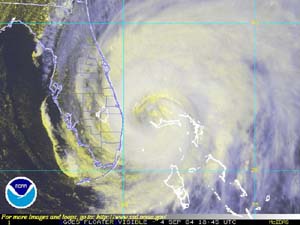 Sept.
4, 2004 — At 5 p.m. EDT, the large eye of Hurricane Frances was
located by NOAA radar and surface observations near latitude 26.9 north,
longitude 79.3 west or about 50 miles east-northeast of Palm Beach, Fla.
Frances has been nearly stationary for the past several hours, but the
hurricane should begin to move between the west and west-northwest near
5 mph soon. On this track, the strongest winds surrounding the large eye
of Frances will move across the Florida east coast Saturday night, according
to the NOAA Hurricane Center in
Miami, Fla. (Click NOAA “false color” close-up satellite
image for larger view of Hurricane Frances taken at 2:45 p.m. EDT on Sept.
4, 2004, as the large eye of the storm continues to move closer to the
east coast of Florida. Click
here for high resolution version, which is a large file. Please credit
“NOAA.”)
Sept.
4, 2004 — At 5 p.m. EDT, the large eye of Hurricane Frances was
located by NOAA radar and surface observations near latitude 26.9 north,
longitude 79.3 west or about 50 miles east-northeast of Palm Beach, Fla.
Frances has been nearly stationary for the past several hours, but the
hurricane should begin to move between the west and west-northwest near
5 mph soon. On this track, the strongest winds surrounding the large eye
of Frances will move across the Florida east coast Saturday night, according
to the NOAA Hurricane Center in
Miami, Fla. (Click NOAA “false color” close-up satellite
image for larger view of Hurricane Frances taken at 2:45 p.m. EDT on Sept.
4, 2004, as the large eye of the storm continues to move closer to the
east coast of Florida. Click
here for high resolution version, which is a large file. Please credit
“NOAA.”)
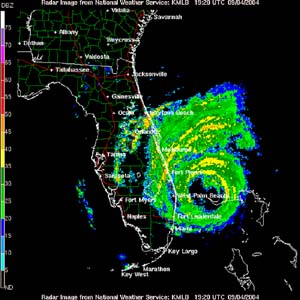 Maximum
sustained winds are near 105 mph with higher gusts. Some strengthening
is possible before landfall. (Click NOAA National Weather Service
Melbourne, Fla., Doppler radar image for larger view of Hurricane Frances
taken at 3:20 p.m. EDT on Sept. 4, 2004, as the eye of the powerful and
large storm slowly edges toward the Florida east coast. Click
here for high resolution version, which is a large file. Please credit
“NOAA.”)
Maximum
sustained winds are near 105 mph with higher gusts. Some strengthening
is possible before landfall. (Click NOAA National Weather Service
Melbourne, Fla., Doppler radar image for larger view of Hurricane Frances
taken at 3:20 p.m. EDT on Sept. 4, 2004, as the eye of the powerful and
large storm slowly edges toward the Florida east coast. Click
here for high resolution version, which is a large file. Please credit
“NOAA.”)
Hurricane force winds extend outward up to 75 miles from the center, and
tropical storm force winds extend outward up to 205 miles. Strong winds
are already affecting the east coast of Florida and will be spreading
inland where warnings for hurricane and tropical storm force winds have
been issued.
Estimated minimum central pressure is 962 mb, 28.41 inches.
![]() Storm
surge flooding of 3 to 5 feet above normal tide levels can still be possible
on the west side of islands of the northern Bahamas. (Click NOAA
image for larger view of 5 p.m. EDT Hurricane Frances tracking map for
Sept. 4, 2004.)
Storm
surge flooding of 3 to 5 feet above normal tide levels can still be possible
on the west side of islands of the northern Bahamas. (Click NOAA
image for larger view of 5 p.m. EDT Hurricane Frances tracking map for
Sept. 4, 2004.)
Coastal storm surge flooding of 4 to 6 feet above normal tide levels,
along with large and dangerous battering waves, is expected near and to
the north of where the center makes landfall in Florida. Storm surge flooding
of 5 feet above normal levels is expected in Lake Okeechobee. Along the
southwest Florida coast storm surge flooding of 1 to 3 feet above normal
tide levels is expected south of the path of Frances.
Storm total rainfall amounts could reach 20 inches in the northwest Bahamas.
Rainfall amounts of 8 to 12 inches, with locally higher amounts to near
20 inches, are expected over the Florida peninsula in association with
Frances.
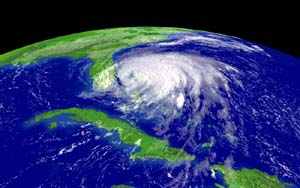 Isolated
tornadoes are possible over portions of central and south Florida Saturday
night. (Click NOAA satellite image for larger view of Hurricane
Frances taken at 8:45 a.m. EDT on Sept. 4, 2004, as the storm begins to
lash the east coast of Florida. Click
here for high resolution version, which is a large file. Please credit
“NOAA.”)
Isolated
tornadoes are possible over portions of central and south Florida Saturday
night. (Click NOAA satellite image for larger view of Hurricane
Frances taken at 8:45 a.m. EDT on Sept. 4, 2004, as the storm begins to
lash the east coast of Florida. Click
here for high resolution version, which is a large file. Please credit
“NOAA.”)
A hurricane warning remains in effect for the east coast of Florida from Florida City northward to Flagler Beach, including Lake Okeechobee. A hurricane warning remains in effect for Grand Bahama, Abaco, Bimimi and the Berry Islands.
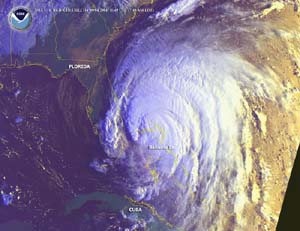 At
5 p.m. EDT, the hurricane warning is discontinued for the remainder of
the northwestern Bahamas. (Click NOAA close-up satellite image
for larger view of Hurricane Frances taken at 7:49 a.m. EDT on Sept. 4,
2004, as the large storm moved closer to the Florida east coast. Click
here for high resolution version, which is a large file. Please credit
“NOAA.”)
At
5 p.m. EDT, the hurricane warning is discontinued for the remainder of
the northwestern Bahamas. (Click NOAA close-up satellite image
for larger view of Hurricane Frances taken at 7:49 a.m. EDT on Sept. 4,
2004, as the large storm moved closer to the Florida east coast. Click
here for high resolution version, which is a large file. Please credit
“NOAA.”)
A hurricane
warning means that hurricane conditions are expected within the warning
area within the next 24 hours. Preparations to protect life and property
should be rushed to completion.
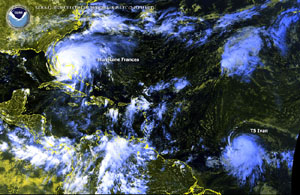 A
tropical storm warning remains in effect from north of Flagler Beach to
Altamaha Sound. A hurricane watch remain in effect from north of Flagler
Beach to Fernandina Beach. (Click NOAA satellite image for larger
view of Hurricane Frances and Tropical Storm Ivan taken at 2:45 p.m. EDT
on Sept. 4, 2004, as both storms churn in the Atlantic. Click
here for high resolution version, which is a large file. Please credit
“NOAA.”)
A
tropical storm warning remains in effect from north of Flagler Beach to
Altamaha Sound. A hurricane watch remain in effect from north of Flagler
Beach to Fernandina Beach. (Click NOAA satellite image for larger
view of Hurricane Frances and Tropical Storm Ivan taken at 2:45 p.m. EDT
on Sept. 4, 2004, as both storms churn in the Atlantic. Click
here for high resolution version, which is a large file. Please credit
“NOAA.”)
At 5 p.m.
EDT, the tropical storm warning was extended northward along the Florida
west coast to St. Marks. A tropical storm warning is now in effect for
the Florida peninsula on the west coast from St. Marks southward around
the southern end of the peninsula to just south of Florida City on the
southeast coast, and for the middle and upper Keys from south of Florida
City to the Seven Mile Bridge and for Florida Bay.
The tropical storm watch was extended along the Florida panhandle from
west of St. Marks to Panama City.
NOAA is dedicated to enhancing economic security and national safety through the prediction and research of weather and climate-related events and providing environmental stewardship of the nationís coastal and marine resources. NOAA is part of the U.S. Department of Commerce.
Relevant
Web Sites
NOAA
National Hurricane Center —
Get the latest advisories here
NOAA Hurricane Frances Archived Images from the NOAA Visualization Lab
NOAA
Satellite Services Division — Latest Images
NOAA 3-D Satellite Images
NOAA Enhanced Satellite
Images
NOAA Atlantic Hurricanes
Database — 150 Years of Atlantic Hurricanes
Above-normal
2004 Atlantic Hurricane Season Predicted
Saffir-Simpson Hurricane
Scale
NOAA Flood Products
NOAA
Inland Flooding Information
Significant
River Flood Outlook
NOAA Rainfall Graphics
24-hour
Observed Precipitation as of 8 a.m. today
Latest
rainfall data as of 8 a.m. EDT today
NOAA Buoys
NOAA
Tides Online
NOAA Satellite Images — The
latest satellite views
Colorized Satellite Images
NOAA Hurricanes Page
NOAA Storm Watch —
Get the latest severe weather information across the USA
Media
Contact:
Frank Lepore, NOAA
Hurricane Center, (305) 229-4404